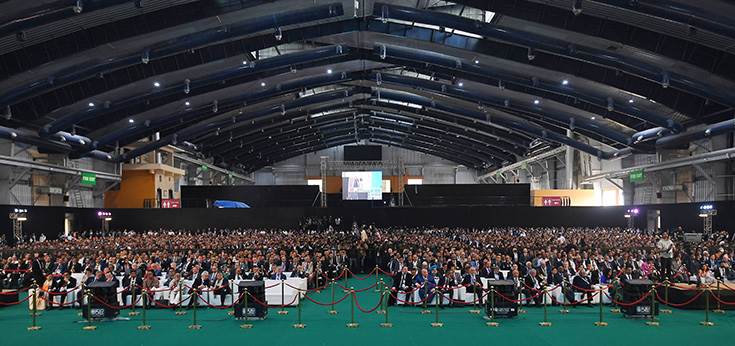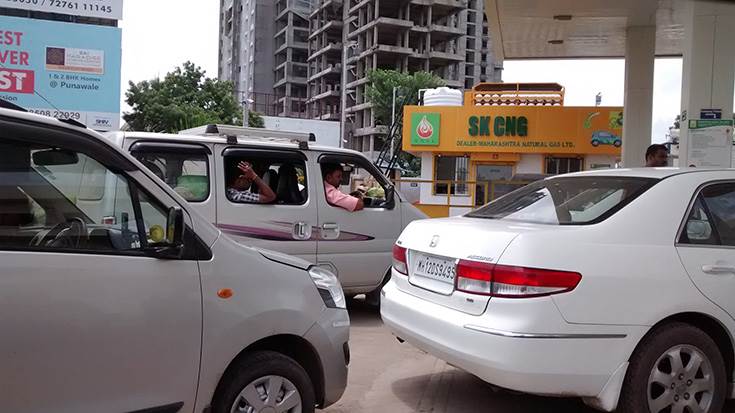Prime Minister Narendra Modi inaugurated the India Energy Week (IEW) 2023 in Bengaluru today. India Energy Week is underway from February 6-8 and aims to showcase India’s rising prowess as an energy transition powerhouse.
The event brings together leaders from the traditional and non-traditional energy industry, governments, and academia to discuss the challenges and opportunities that a responsible energy transition presents. Over 30,000 delegates, 1,000 exhibitors and 500 speakers are at India Energy Week and will discuss the challenges and opportunities of India’s energy future.
Among the key events today were the launch of E20 fuel and the Green Mobility Rally where vehicles running on green energy sources will help create public awareness for green fuels.
 India Energy Week will see over 30,000 delegates, 1,000 exhibitors and 500 speakers discuss the challenges and opportunities of India’s energy future.
India Energy Week will see over 30,000 delegates, 1,000 exhibitors and 500 speakers discuss the challenges and opportunities of India’s energy future.
Launch of E20 fuel
Prime Minister Modi also launched E20 fuel at 84 retail outlets of oil marketing companies in 11 States/UTs along the lines of the ethanol blending roadmap. “We are aiming to have 50% non-fossil fuel capacity by the end of this decade. We are also working very fast on biofuel and ethanol blending. In the last nine years, we have increased ethanol blending in petrol from 1.5% to 10% and now we are moving towards the target of 20% ethanol blending,” he said. Referring to the E20 rollout today, the Prime Minister said that the first phase of the rollout will cover 15 cities and within two years it will be expanded across the entire country.
He said that India Energy Week is the first significant energy event of the G20 calendar and underlines the major role of the energy sector in setting the direction of the future of the 21st-century world. “India is one of the strongest voices in the world for energy transition and for developing new resources of energy. Unprecedented possibilities are emerging in India that is moving with a resolution of a Viksit Bharat.”
Emphasising the need and demand for energy in India in the near future, the Prime Minister noted that the rapid pace of development in India will result in new cities being developed. Quoting International Energy Association, the Prime Minister remarked that India’s energy demands will be highest in the present decade which presents an opportunity for the investors and stakeholders of the energy sector. He informed that India’s share in the global oil demand is 5% which is expected to rise to 11%, whereas the gas demand of India is expected to rise up to 500%. He underlined that new opportunities for investment and collaboration are being created by the expanding energy sector of India.
Four-pronged energy strategy
The Prime Minister explained four major verticals for the strategy for the energy sector.
– Increasing domestic exploration and production,
– Diversifying the supply,
– Expanding fuels like biofuel, ethanol, compressed biogas and solar.
– De-carbonisation via electric vehicles and hydrogen.
Elaborating on these verticals, the Prime Minister said India is the fourth largest country for its refining capacity. Efforts are on to increase the capacity to 450 MMTPA from the current capacity of 250 MMTPA. “We are continuously making our refining capacity indigenous, modern and upgraded”, he said.
He said that the government is working to increase the consumption of natural gas in the country’s energy mix from 6% to 15% by 2030 where all the needed infrastructure will be provided by the ‘One Nation One Grid’.
“The government is trying to increase the capacity of LNG Terminal regasification”, the Prime Minister said. He further added that the terminal regasification capacity of 21 MMTPA has doubled in 2022 while efforts are being made to increase it even more.
He also added that the number of CGDs in the country has gone up nine times and the number of CNG stations has gone up to 5,000 from 900 in 2014. He also touched upon the gas pipeline network which has increased to 22,000 kilometres from 14,000km in 2014 and pointed out that the network will expand to 35,000km in the next 4-5 years.

The number of CNG-filling stations has gone up to 5,000 from 900 in 2014.
As regards bio-energy expansion, the Prime Minister talked about the first 2G Ethanol bio-refinery in August last year and said that preparation is for 12 commercial 2G Ethanol plants. Similarly, efforts are underway for commercial feasibility of sustainable aviation fuel and renewable diesel. Mentioning the provisions of this year’s Budget, he said about 500 new ‘waste to wealth’ Gobardhan plants, 200 compressed biogas plants and 300 community-based plants which will create new avenues of investments.
“The National Green hydrogen mission will give a new direction to the India of the 21st century,” the Prime Minister remarked. He underlined that the country is aiming to produce 5 MMTPA green hydrogen by the end of this decade which brings in the possibility of investments of more than Rs 8 lakh crore. He also added that India will increase the share of green hydrogen to 25 percent by replacing grey hydrogen.
Touching upon the subject of battery cost in EVs, he noted that the cost is 40-50 percent of the cost of an EV and . He informed that the government has started a PLI scheme worth 18,000 crores which will be a significant step towards manufacturing advanced chemistry cells of 50 GigaWatt hours.
The Prime Minister gave a detailed exposition of emphasis on renewable energy, energy efficiency, sustainable transportation and green technologies in the new budget. 35,000 crores have been kept for priority capital investment to push energy transition and net-zero objectives. Provision for 10 lakh crore rupees capital expenditure will give a push to green hydrogen, and solar-to-road infrastructure.
The governor of Karnataka, Thawar Chand Gehlot; Chief Minister of Karnataka, Basvaraj Bommai, Union Minister for Petroleum and Natural Gas, Hardeep Singh Puri and Union Minister of State for Petroleum and Natural Gas, Rameshwar Teli were present on the occasion among others.
All images: PIB
